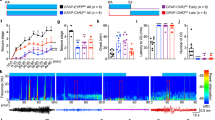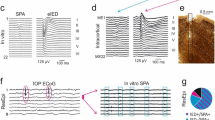Abstract
Hypersynchronous neuronal firing is a hallmark of epilepsy, but the mechanisms underlying simultaneous activation of multiple neurons remains unknown. Epileptic discharges are in part initiated by a local depolarization shift that drives groups of neurons into synchronous bursting. In an attempt to define the cellular basis for hypersynchronous bursting activity, we studied the occurrence of paroxysmal depolarization shifts after suppressing synaptic activity using tetrodotoxin (TTX) and voltage-gated Ca2+ channel blockers. Here we report that paroxysmal depolarization shifts can be initiated by release of glutamate from extrasynaptic sources or by photolysis of caged Ca2+ in astrocytes. Two-photon imaging of live exposed cortex showed that several antiepileptic agents, including valproate, gabapentin and phenytoin, reduced the ability of astrocytes to transmit Ca2+ signaling. Our results show an unanticipated key role for astrocytes in seizure activity. As such, these findings identify astrocytes as a proximal target for the treatment of epileptic disorders.
This is a preview of subscription content, access via your institution
Access options
Subscribe to this journal
Receive 12 print issues and online access
$209.00 per year
only $17.42 per issue
Buy this article
- Purchase on Springer Link
- Instant access to full article PDF
Prices may be subject to local taxes which are calculated during checkout






Similar content being viewed by others
References
Najm, I.M., Janigro, D. & Babb, T.L. Mechanisms of epileptogenesis and experimental models of seizures. in The Treatment of Epilepsy: Principles and Practice (ed. Wyllie, E.) 33–44 (Lippincott, Williams and Wilkins, New York, 2001).
Heinemann, U., Gabriel, S., Schuchmann, S. & Eder, C. Contribution of astrocytes to seizure activity. Adv. Neurol. 79, 583–590 (1999).
Rogawski, M.A. & Loscher, W. The neurobiology of antiepileptic drugs. Nat. Rev. Neurosci. 5, 553–564 (2004).
Meldrum, B.S. Update on the mechanism of action of antiepileptic drugs. Epilepsia 37 Suppl. 6, S4–11 (1996).
Parpura, V. et al. Glutamate-mediated astrocyte-neuron signalling. Nature 369, 744–747 (1994).
Bezzi, P. et al. Prostaglandins stimulate calcium-dependent glutamate release in astrocytes. Nature 391, 281–285 (1998).
Fellin, T. et al. Neuronal synchrony mediated by astrocytic glutamate through activation of extrasynaptic NMDA receptors. Neuron 43, 729–743 (2004).
Angulo, M.C., Kozlov, A.S., Charpak, S. & Audinat, E. Glutamate released from glial cells synchronizes neuronal activity in the hippocampus. J. Neurosci. 24, 6920–6927 (2004).
Luhmann, H.J., Dzhala, V.I. & Ben-Ari, Y. Generation and propagation of 4-AP-induced epileptiform activity in neonatal intact limbic structures in vitro. Eur. J. Neurosci. 12, 2757–2768 (2000).
Yamaguchi, S. & Rogawski, M.A. Effects of anticonvulsant drugs on 4-aminopyridine-induced seizures in mice. Epilepsy Res. 11, 9–16 (1992).
Elmslie, K.S. Neurotransmitter modulation of neuronal calcium channels. J. Bioenerg. Biomembr. 35, 477–489 (2003).
Drew, G.M. & Vaughan, C.W. Multiple metabotropic glutamate receptor subtypes modulate GABAergic neurotransmission in rat periaqueductal grey neurons in vitro. Neuropharmacology 46, 927–934 (2004).
Grimaldi, M., Atzori, M., Ray, P. & Alkon, D.L. Mobilization of calcium from intracellular stores, potentiation of neurotransmitter-induced calcium transients, and capacitative calcium entry by 4-aminopyridine. J. Neurosci. 21, 3135–3143 (2001).
Schuchmann, S., Albrecht, D., Heinemann, U. & von Bohlen und Halbach, O. Nitric oxide modulates low-Mg2+-induced epileptiform activity in rat hippocampal-entorhinal cortex slices. Neurobiol. Dis. 11, 96–105 (2002).
Schneiderman, J.H. The role of long-term potentiation in persistent epileptiform burst-induced hyperexcitability following GABAA receptor blockade. Neuroscience 81, 1111–1122 (1997).
Jones, M.S. & Barth, D.S. Effects of bicuculline methiodide on fast (>200 Hz) electrical oscillations in rat somatosensory cortex. J. Neurophysiol. 88, 1016–1025 (2002).
Perez-Velazquez, J.L., Valiante, T.A. & Carlen, P.L. Modulation of gap junctional mechanisms during calcium-free induced field burst activity: a possible role for electrotonic coupling in epileptogenesis. J. Neurosci. 14, 4308–4317 (1994).
Cotrina, M.L. et al. Connexins regulate calcium signaling by controlling ATP release. Proc. Natl Acad. Sci. USA 95, 15735–15740 (1998).
Cotrina, M.L., Lin, J.H., Lopez-Garcia, J.C., Naus, C.C. & Nedergaard, M. ATP-mediated glia signaling. J. Neurosci. 20, 2835–2844 (2000).
Kang, J., Jiang, L., Goldman, S. & Nedergaard, M. Astrocyte-mediated potentiation of inhibitory synaptic transmission. Nat. Neurosci. 1, 683–692 (1998).
Zonta, M. et al. Neuron-to-astrocyte signaling is central to the dynamic control of brain microcirculation. Nat. Neurosci. 6, 43–50 (2003).
Liu, Q.S., Xu, Q., Arcuino, G., Kang, J. & Nedergaard, M. Astrocyte-mediated activation of neuronal kainate receptors. Proc. Natl. Acad. Sci. USA 101, 3172–3177 (2004).
Ransom, B., Behar, T. & Nedergaard, M. New roles for astrocytes (stars at last). Trends Neurosci. 26, 520–522 (2003).
Nedergaard, M., Ransom, B. & Goldman, S.A. New roles for astrocytes: Redefining the functional architecture of the brain. Trends Neurosci. 26, 523–530 (2003).
Jeremic, A., Jeftinija, K., Stevanovic, J., Glavaski, A. & Jeftinija, S. ATP stimulates calcium-dependent glutamate release from cultured astrocytes. J. Neurochem. 77, 664–675 (2001).
Nedergaard, M., Takano, T. & Hansen, A.J. Beyond the role of glutamate as a neurotransmitter. Nat. Rev. Neurosci. 3, 748–755 (2002).
Obrenovitch, T.P., Urenjak, J. & Zilkha, E. Evidence disputing the link between seizure activity and high extracellular glutamate. J. Neurochem. 66, 2446–2454 (1996).
Mena, F.V., Baab, P.J., Zielke, C.L. & Zielke, H.R. In vivo glutamine hydrolysis in the formation of extracellular glutamate in the injured rat brain. J. Neurosci. Res. 60, 632–641 (2000).
Benveniste, H. & Huttemeier, P.C. Microdialysis–theory and application. Prog. Neurobiol. 35, 195–215 (1990).
Nimmerjahn, A., Kirchhoff, F., Kerr, J. & Helmchen, F. Sulforhodamine 101 as a specific marker of astroglia in the neocortex in vivo. Nat. Methods 1, 31–37 (2004).
Hirase, H., Creso, J. & Buzsaki, G. Capillary level imaging of local cerebral blood flow in bicuculline-induced epileptic foci. Neuroscience 128, 209–216 (2004).
Tashiro, A., Goldberg, J. & Yuste, R. Calcium oscillations in neocortical astrocytes under epileptiform conditions. J. Neurobiol. 50, 45–55 (2002).
Rothstein, J.D. et al. Knockout of glutamate transporters reveals a major role for astroglial transport in excitotoxicity and clearance of glutamate. Neuron 16, 675–686 (1996).
Duffy, S. & MacVicar, B. Modulation of neuronal excitability by astrocytes. in Jasper's Basic Mechanisms of the Epilepsies 3rd edn: Advances in Neurology, Vol 79 (eds. Delgado-Escueta, A., Wilson, W., Olsen, R. & Porter, R.) 573–581 (Lippincott Williams & Wilkins, Philadelphia, 1999).
Haydon, P.G. Glia: listening and talking to the synapse. Nat. Rev. Neurosci. 2, 185–193 (2001).
Miles, R. & Wong, R.K. Single neurones can initiate synchronized population discharge in the hippocampus. Nature 306, 371–373 (1983).
Heinemann, U., Konnerth, A., Pumain, R. & Wadman, W.J. Extracellular calcium and potassium concentration changes in chronic epileptic brain tissue. Adv. Neurol. 44, 641–661 (1986).
Stout, C. & Charles, A. Modulation of intercellular calcium signaling in astrocytes by extracellular calcium and magnesium. Glia 43, 265–273 (2003).
Ye, Z.C., Wyeth, M.S., Baltan-Tekkok, S. & Ransom, B.R. Functional hemichannels in astrocytes: a novel mechanism of glutamate release. J. Neurosci. 23, 3588–3596 (2003).
Arcuino, G. et al. Intercellular calcium signaling mediated by point-source burst release of ATP. Proc. Natl. Acad. Sci. USA 99, 9840–9845 (2002).
Nedergaard, M. Direct signaling from astrocytes to neurons in cultures of mammalian brain cells. Science 263, 1768–1771 (1994).
Bikson, M., Ghai, R.S., Baraban, S.C. & Durand, D.M. Modulation of burst frequency, duration, and amplitude in the zero-Ca(2+) model of epileptiform activity. J. Neurophysiol. 82, 2262–2270 (1999).
Carmignoto, G., Pasti, L. & Pozzan, T. On the role of voltage-dependent calcium channels in calcium signaling of astrocytes in situ. J. Neurosci. 18, 4637–4645 (1998).
Rogawski, M.A. & Loscher, W. The neurobiology of antiepileptic drugs for the treatment of nonepileptic conditions. Nat. Med. 10, 685–692 (2004).
Takano, T. et al. Glutamate release promotes growth of malignant gliomas. Nat. Med. 7, 1010–1015 (2001).
Valiante, T.A., Perez Velazquez, J.L., Jahromi, S.S. & Carlen, P.L. Coupling potentials in CA1 neurons during calcium-free-induced field burst activity. J. Neurosci. 15, 6946–6956 (1995).
Ayala, G.X. & Tapia, R. Expression of heat shock protein 70 induced by 4-aminopyridine through glutamate-mediated excitotoxic stress in rat hippocampus in vivo. Neuropharmacology 45, 649–660 (2003).
Urenjak, J. & Obrenovitch, T.P. Kynurenine 3-hydroxylase inhibition in rats: effects on extracellular kynurenic acid concentration and N-methyl-D-aspartate-induced depolarisation in the striatum. J. Neurochem. 75, 2427–2433 (2000).
Boothe, D.M. Anticonvulsant therapy in small animals. Vet. Clin. North Am. Small Anim. Pract. 28, 411–448 (1998).
Acknowledgements
We thank S. Goldman, S. Rothman, H. Yeh, T. Obrenovitch and E. Vates for their comments. This work was supported in part by US National Institutes of Health and National Institute of Neurological Disorders and Stroke grants NS30007 and NS38073 (to M.N.), NS39997 (to J.K.) and HD16596 (to H.R.Z.).
Author information
Authors and Affiliations
Corresponding author
Ethics declarations
Competing interests
The authors declare no competing financial interests.
Rights and permissions
About this article
Cite this article
Tian, GF., Azmi, H., Takano, T. et al. An astrocytic basis of epilepsy. Nat Med 11, 973–981 (2005). https://doi.org/10.1038/nm1277
Received:
Accepted:
Published:
Issue Date:
DOI: https://doi.org/10.1038/nm1277
This article is cited by
-
The role of extracellular glutamate homeostasis dysregulated by astrocyte in epileptic discharges: a model evidence
Cognitive Neurodynamics (2023)
-
Astrocytes in the initiation and progression of epilepsy
Nature Reviews Neurology (2022)
-
Activated astrocytes attenuate neocortical seizures in rodent models through driving Na+-K+-ATPase
Nature Communications (2022)
-
Inhibition of Transient Receptor Potential Vanilloid 4 (TRPV4) Mitigates Seizures
Neurotherapeutics (2022)
-
Altered adult neurogenesis and gliogenesis in patients with mesial temporal lobe epilepsy
Nature Neuroscience (2022)



